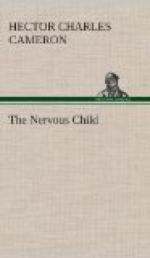movement, will often quiet an incipient storm.
The longer he cries, the more trouble it is to soothe
him. Sleep provokes sleep, so that often we find
restlessness and sound sleep alternating in a sort
of cycle, a good week perhaps following a bad one.
The nurse who is quick to cut short a storm of crying
and to soothe the child again to sleep is helping
him to form habits of sleep. The nurse who leaves
him to cry, believing that in time he will of his
own accord recognise the futility of his behaviour,
is making him form habits of crying. A rigid
routine in sleep is a good thing, but the routine
belongs to the baby, not to the nurse. The child
must be educated to sleep, not taught to cry.
A baby has but little power of altering his position
when it becomes strained or uncomfortable. He
cannot turn over and nestle down into a new posture.
If we watch him wake, the first stirring may be very
gradual, and in a moment he may fall again to sleep.
A few minutes later he stirs again more strongly,
and is wider awake and for longer. It may only
be after a third waking, by a summation of stimuli,
that he is finally roused and breaks into loud crying.
The nurse who is on the watch, who, sleeping beside
him, wakes at the slightest sound and is quick to turn
him over and settle him into a new position of rest,
will probably report in the morning that the baby
has had a good night. The nurse who lets the
child grow wide awake and start crying loudly, will
spend perhaps many hours before quiet is again restored.
Of the voluntary, purposive crying of infants a little
older I am not here speaking. Infants in the
second six months are quite capable of establishing
a “Tyranny of Tears” and feeling their
power. Fortunately it requires no great experience
to distinguish one from the other, and to adopt for
each the appropriate treatment.
Again, in elementary teaching upon the management
of infants stress is laid, rightly enough, upon the
importance of regularity in the times of feeding,
and on the observance in this respect also of a very
strict routine. But in the case of the very nervous
infant a certain latitude should be allowed to an
experienced nurse or mother. We may wreck everything
by a blind adhesion to a too rigid scheme, which may
demand that we leave the child to scream for an hour
before his meal, or that, when at length he has fallen
into a sound sleep after hours of wakefulness, we
should proceed to wake him.
Symptoms of dyspepsia which are due to continued nervous
excitement demand treatment which is very different
from that which would be appropriate to dyspepsia
which is due to other causes, such as overfeeding
or unsuitable feeding. The temporary restriction
of food, which is commonly ordered in dyspepsia from
these causes, is very badly supported by the nervous
infant. Hunger invariably increases the unrest,
and the unrest increases the dyspepsia.
The difficulties of managing a nervous infant are
very real, and call for the most exemplary patience
on the part of the mother and the clearest insight
into the nature of the disturbance.




